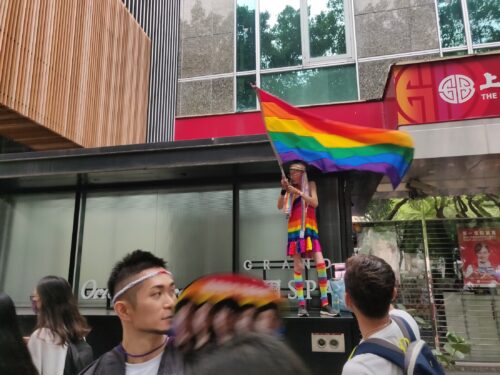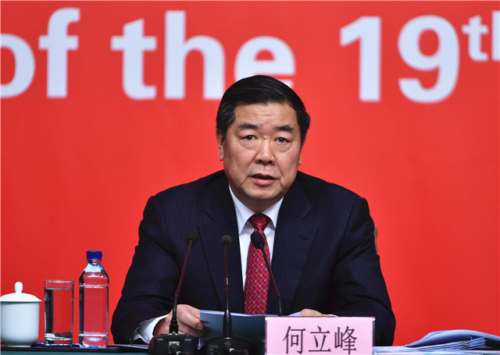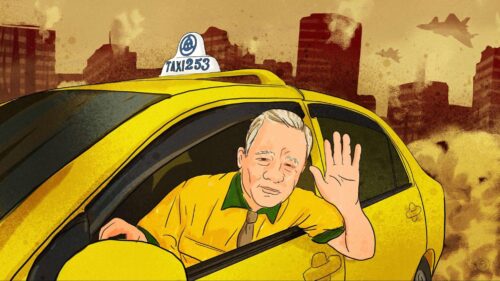
Xinjiang's history as a penal colony and then a high-tech laboratory has resulted in one of the most sophisticated and all-encompassing surveillance networks in the world to be deployed there. Other places may be next.

During the 2019 protests in Hong Kong, a frequent refrain from democracy advocates was “Yesterday Xinjiang and Tibet, today Hong Kong, tomorrow Taiwan.”
Across these places, local social institutions have been overwhelmed, to varying degrees, by the wealth and power brought in by China’s rising political and economic might.
Yet there are also reasons to believe that Hong Kong and Taiwan will not be subject to the Xinjiang model of overwhelming control. At least, not to the same extent.
Xinjiang as penal colony
For nearly 300 years, Xinjiang has functioned as a “penal colony” (监狱翁民地 jiānyù wēng mín dì), a history that makes it unique relative to Hong Kong and Taiwan. The origins of this phrase in the context of Xinjiang began soon after the Manchu-led Qing armies, with a mix of help and resistance from local Turkic Muslims, massacred the Dzungar Mongols in the northern part of the region in the 1740s. In order to maintain control of Mongol and Kazakh ancestral lands in Northern Xinjiang, the Qianlong administration began a project to transfer non-native Han people (along with some Hui Muslims and other ethnic minorities) into military colonies built on the frontier. Hoping to make it a self-sustaining occupation, they sent tens of thousands of non-Muslim convicts to the region, as well as subsidized Han farmers, to settle in tightly controlled plantations.
As the scholar Joanna Waley-Cohen notes, the criminal population sent there had been deemed guilty of political offenses or petty crimes such as robbery. They were “scholars, sectarians, bureaucrats, eunuchs, imperial clansmen, bannermen, soldiers, pirates, merchants, actors, farmers, slaves and others, men, women, and children.” For them, exile to Xinjiang was a punishment second only to death. Meanwhile, migration for Han farmers was a way of escaping extreme poverty. For both groups, settlement in the penal colony meant they would live the rest of their lives isolated from the communities they had known before, and with extreme restrictions on their freedom. They could not choose where they lived or what conditions they worked under.
Yet, though they often had no choice in their move to Xinjiang, over time Han people, and Hui people from Gansu and Ningxia, came to dominate the institutions of what would later become known as Northern Xinjiang. According to available census data, by 1803, 155,000 Han and Hui lived in the north while around 320,000 Uyghurs continued to live in their ancestral homelands south of the Tian Shan mountain range, where, until 1831, Han and Hui were forbidden to move. This number of settlers grew to around 200,000 by the end of the century, and the archipelago of penal colonies led to the formal establishment of the People’s Production and Construction Corps colonies after the People’s Republic was founded in 1949.
During the Maoist period, Xinjiang remained a site of exile and imprisonment. Because the non-Muslim population of the region had dwindled to only around 5 percent of the population, the Chinese Communist Party made the Han settlement in the Inner Asian frontiers of Xinjiang and Tibet a priority. Over the next decades, millions of people from criminalized groups and other coerced citizens were settled in the revived network of penal colonies in Xinjiang. For example, tens of thousands of criminalized Kuomintang soldiers who could not escape to Taiwan were sent there, along with Communist Party officials who were deemed counterrevolutionaries or “rightists.” These include the well-known poet Ài Qīng 艾青 (the father of artist Ài Wèiwèi 艾未未), who was exiled to Xinjiang in 1959 and forced into physical labor for five years.

As former political criminals were rehabilitated after the Cultural Revolution, an interesting thing happened to the legacy of the penal colony. The former criminals of the Qing period who were banished to Xinjiang were turned into heroes of the nation. For example, the Chinese official Lín Zéxú 林则徐, sent to Xinjiang in the 1840s due to his failure to address the opium crisis caused by British imperialism, was memorialized with a prominent statue in Hong Shan Park in downtown Ürümchi. The past presence of Han penal colonies and military occupations in previous centuries allowed state histories to be rewritten to say that Han people had always lived in Xinjiang, that they were natives just like the Uyghurs, Kazakhs, and Mongols whose ancestors had lived there for millennia. This retelling of settler history, as well as the existing infrastructure of prisons and camps, is part of what motivated the descendants of former prisoner-colonists to criminalize the indigenous population of Uyghurs and Kazakhs and put them into a new system of penal colonies. Unlike Taiwan and Hong Kong, Xinjiang is a site where the descendants of former prisoners have become wardens.
In some ways, the position of settler colonizers in Xinjiang mirrors the positions of Han people who fled to Taiwan. In both cases, the indigenous populations of these spaces have been marginalized. An important difference, however, is that over the past two decades, many Han people in Taiwan have striven to give the first peoples of the island greater institutional support and autonomy. In Xinjiang, the inverse has occurred. Han people there have begun a process of eliminating and replacing Uyghur identity.
They are using the contemporary penal colony system to hold Muslims in place and put them to work in factories where their labor is undervalued and unfree. They have taken Muslim children from Muslim families and put them in residential boarding schools where they are drilled to disavow their heritage. And, like populations who embrace dominant counter-terrorism rhetoric and imagery in places like the United States, Israel, and India, they have become enamored with anti-Muslim racism, assuming that Muslims are inherently violent and must be controlled. This has resulted in a system of surveillance that is paradoxically both extremely sophisticated and blind.
Xinjiang as high-tech laboratory
The “high-tech” aspect of the contemporary penal colony means that certain aspects of the camp and factory system are automated. It also means that the perspectives of the non-Muslims who designed and implemented the system become an unquestioned truth. If they decide that a Muslim going to a mosque more than 200 times or studying the Quran is a sign of extremist activity, the technicians who maintain the system and the authorities who enforce the judgments of the system will all conspire to say this is in fact the case. The system becomes ham-fisted, dictated by algorithm.
While the algorithm is meant to predict the possibility of criminality, in many cases the predictions generated by scanning Muslims’ phones are taken to be the truth, reinforced by forced confessions through brutal interrogations. State officials and settler citizens determine that Muslims are guilty until proven innocent, and technology is a means to verify these assumptions. This has meant that hundreds of thousands of innocent people have been turned into supposed “terrorists” in the amount of time it takes to scan their phones.
Muslims in Xinjiang are trapped behind a constant low-level digital siege. No matter where they go or what they do, their behavior online and in real life is subjected to continuous, automated assessment. Their ability to maintain an autonomous existence, to narrate their own life stories, while not fully eliminated, is deeply constrained by this system. And they are isolated from each other, far away from their loved ones and home communities, and by the fear that anything they say or do could be recorded and assessed by informants and cameras.
But it also means that technology companies like HikVision and Dahua have benefited tremendously from state contracts and unlimited access to public data. These forms of capital accumulation have allowed Chinese AI companies to expand their research and development, pushing them to the forefront in applications such as facial recognition and data analytics. In many cases, their skills and capabilities now surpass the U.S.-based universities and companies where many of China’s lead technologists were trained. And the scope and scale of policing in Xinjiang itself is now comparable to the forms of control Israel exerts over Palestinians, which incidentally is another source of inspiration for the Xinjiang system.
Xinjiang futures of China
The technological controls of social life I describe in Xinjiang are not limited to controlling Muslim bodies. In 2020, Chinese authorities across the country adopted comprehensive, rigid grid-style policing and community surveillance tools similar to those used in Xinjiang to track and control the spread of COVID-19. Rather quickly it became clear that the ubiquitous health code apps that were required of citizens to enter public spaces was being utilized to confirm the need to lock down entire neighborhoods and cities, regardless of whether or not the inhabitants in those places were infected with the virus.
For Uyghurs in Xinjiang, which was subjected to “zero-COVID” policies that were longer and harsher than other parts of the country, it meant that public health controls were folded on top of already extreme forms of social control. And, importantly, it meant that for the first time, the Han settler population of the region, the same people who had helped implement a system to control their Muslim neighbors, were also now controlled by a state-imposed digital enclosure.
It was likely because these Han settler-citizens saw themselves as agents of the state that they felt emboldened to start what became a nationwide protest last November. Though the protests were sparked by a horrific apartment fire in a locked-down apartment complex in Ürümchi, the people most directly impacted by the fire did not take to the streets. Instead, in Xinjiang, as in Tibet, protests against “zero Covid” were surprisingly monoethnic. Uyghur and Tibetans were too tightly controlled by surveillance and internment systems that preceded COVID restrictions, and were unable to claim the same right to protest as the Han Chinese around them.
Hong Kong today, Taiwan tomorrow
In Hong Kong, the police and military also endeavored to learn from Xinjiang. Key leaders of the Xinjiang police and paramilitary forces were moved from Xinjiang to Hong Kong to aid in the preventative policing that they had carried out in Xinjiang. Prior to the implementation of the national security law in 2020, Chinese state media had begun labeling Hong Kong protesters as “terrorists.”
Scholars such as Ching Kwan Lee have shown how Hong Kong has become an internal colony of contemporary China over the past two decades. This process, she argues, is not led by settlers from the mainland as much as by the way key social institutions such as schools and courts have been coopted by proxies for the People’s Republic of China’s government. As a result, Hong Kong citizens no longer have the freedom to pursue an autonomous future. At the same time, the reason why Hong Kong is such a lucrative place for mainland investment is precisely because it is much more connected to the global economy. This means that key infrastructure, such as financial technology and digital communications, remain outside the full control of the Chinese state. So, while the national security law has stifled nearly all visible protest, state authorities in Hong Kong are not able to assess and control the mobility and behavior of regular citizens as they can in Xinjiang.
This protection is even more the case in Taiwan, where a sovereign rule of law and international support prevents proxies and agents of the Chinese state from capturing the basic institutions of society. Taiwan’s position between China and the United States in terms of supply chains and the production of essential technologies such as semiconductors make maintaining peace in Taiwan strategically important. At the same time, the many business and trade interests between Taiwan and China also introduces a kind of seepage facilitated by patron-client relationships. These relationships lead in turn to further infrastructural entanglement and political influence in the form of disinformation campaigns and advertising — some of which is welcomed by Taiwanese citizens. So, while the Taiwanese state attempts to regulate the spread of technology built by Chinese police contractors — including those that benefited the most from the camp system in Xinjiang — some of these surveillance tools nevertheless find their way into Taiwan. Similarly, some Taiwanese news consumers are influenced by disinformation campaigns generated by Chinese state actors. Clearly all three places in the “yesterday Tibet and Xinjiang, today Hong Kong, tomorrow Taiwan” scenario face real danger. But of the three, Taiwan has the most to lose, and also has the greatest force to stop this progression from becoming reality.
Thinking about Taiwan and Xinjiang together is important because doing so might allow people in Taiwan to identify with Uyghurs and the way they have been overwhelmed by a digital enclosure system, treated like animals in need of training. But it might also help them to think about the way many of the parents of the Han settlers in Xinjiang were affiliated with the Kuomintang, and that it may be a matter of fate and social power that they ended up in Xinjiang instead of Taiwan. With just a slight turn of historical circumstances, people in Taiwan could have found themselves in the position of camp workers in Xinjiang. Similarly, there are many Taiwanese connections — just as there are many United States connections — to companies such as Huawei that had a significant footprint in the systems in Xinjiang.
But as much as I want people in Taiwan and other overseas Chinese communities to see the possibility of complicity, I want them to also recognize their relative privilege in relation to Uyghurs. And in that privilege to find a sense of obligation to stand in solidarity with Uyghurs.
Standing with Uyghurs does not mean ignoring the anti-Chinese, Sinophobic racism that is ascendent in places around the world, including the United States and Europe. It does not mean supporting a New Cold War rhetorical stance that positions China in opposition to the United States. Instead, I hope that it would mean standing in opposition to structures of colonialism and oppression that are still present in the United States, China, and Taiwan itself. Doing so could begin enacting processes of transnational decolonial and abolitionist movements, something that the Taiwanese American scholar Shu-mei Shih refers to as a “minor politics.” This kind of movement does not ask for permission from global institutions like the United Nations to act; instead, it would foster community and local social support for people like the Uyghurs who have been thrown into one of the most horrific circumstances in the contemporary world.
This essay is adapted from the preface of the Taiwanese translation of In the Camps: China’s High Tech Penal Colony, which will be published later this year by SpringHill Press | Xinjiang Column archives






